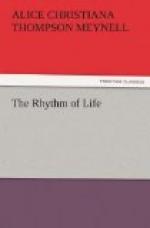THE RHYTHM OF LIFE
If life is not always poetical, it is at least metrical. Periodicity rules over the mental experience of man, according to the path of the orbit of his thoughts. Distances are not gauged, ellipses not measured, velocities not ascertained, times not known. Nevertheless, the recurrence is sure. What the mind suffered last week, or last year, it does not suffer now; but it will suffer again next week or next year. Happiness is not a matter of events; it depends upon the tides of the mind. Disease is metrical, closing in at shorter and shorter periods towards death, sweeping abroad at longer and longer intervals towards recovery. Sorrow for one cause was intolerable yesterday, and will be intolerable tomorrow; today it is easy to bear, but the cause has not passed. Even the burden of a spiritual distress unsolved is bound to leave the heart to a temporary peace; and remorse itself does not remain—it returns. Gaiety takes us by a dear surprise. If we had made a course of notes of its visits, we might have been on the watch, and would have had an expectation instead of a discovery. No one makes such observations; in all the diaries of students of the interior world, there have never come to light the records of the Kepler of such cycles. But Thomas a Kempis knew of the recurrences, if he did not measure them. In his cell alone with the elements—’What wouldst thou more than these? for out of these were all things made’—he learnt the stay to be found in the depth of the hour of bitterness, and the remembrance that restrains the soul at the coming of the moment of delight, giving it a more conscious welcome, but presaging for it an inexorable flight. And ’rarely, rarely comest thou,’ sighed Shelley, not to Delight merely, but to the Spirit of Delight. Delight can be compelled beforehand, called, and constrained to our service—Ariel can be bound to a daily task; but such artificial violence throws life out of metre, and it is not the spirit that is thus compelled. That flits upon an orbit elliptically or parabolically or hyperbolically curved, keeping no man knows what trysts with Time.
It seems fit that Shelley and the author of the Imitation should both have been keen and simple enough to perceive these flights, and to guess at the order of this periodicity. Both souls were in close touch with the spirits of their several worlds, and no deliberate human rules, no infractions of the liberty and law of the universal movement, kept from them the knowledge of recurrences. Eppur si muove. They knew that presence does not exist without absence; they knew that what is just upon its flight of farewell is already on its long path of return. They knew that what is approaching to the very touch is hastening towards departure. ‘O wind,’ cried Shelley, in autumn,
’O wind,
If winter comes, can spring be far
behind?’




